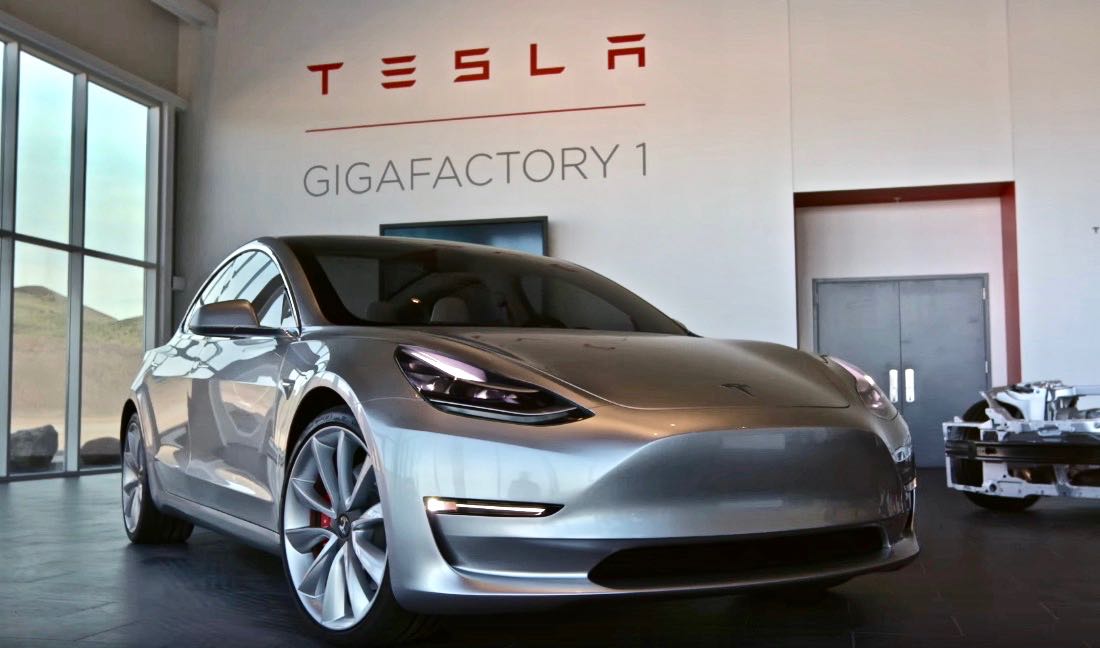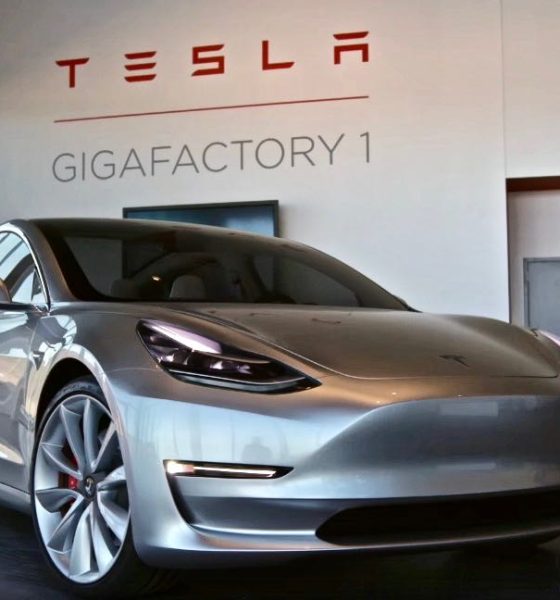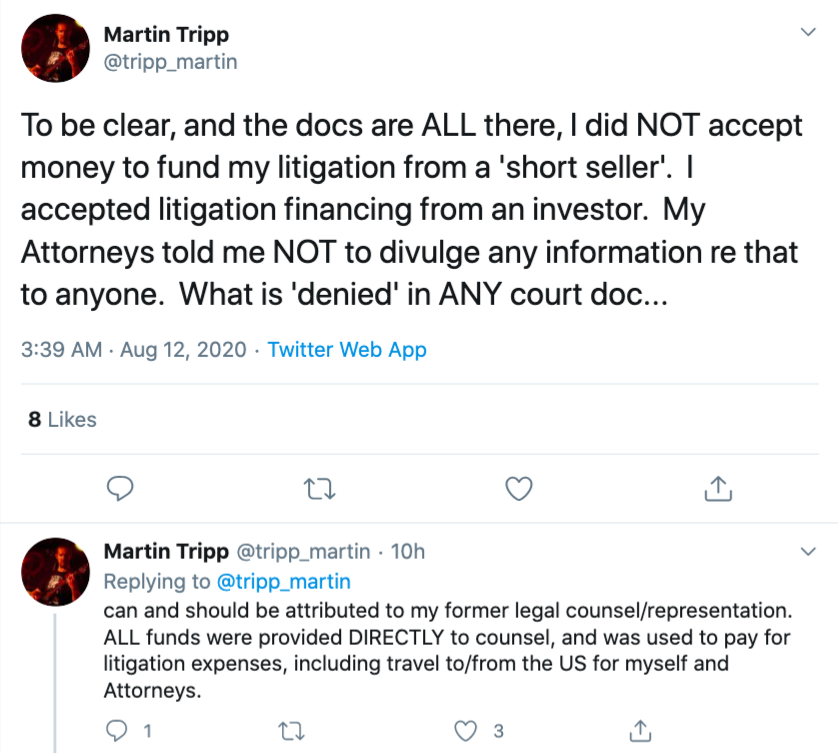

News
Tesla lawsuit defendant fires lawyers after TSLA short financing is revealed
Tesla’s lawsuit against former employee Martin Tripp has taken an unusual turn.
After publishing a large number of documents and videos online over the last week, including many under a confidentiality order in the case, Tripp has now fired his lawyers and will represent himself moving forward. Notably, this action coincided with the revelation that a TSLA short seller, The Funicular Fund, LP (dba Cable Car Capital LLC), was financing Tripp’s legal defense.
The case has been ongoing since 2018 wherein Tesla filed a complaint alleging that Tripp, a former process technician at Gigafactory 1 in Nevada, had stolen several gigabytes of confidential trade secret information and transferred it to third parties. Tripp denies wrongdoing and claims to be a whistleblower reporting evidence of securities fraud and concerns over safety during early Model 3 manufacturing. He has further filed a counterclaim against Tesla in the case, alleging defamation.
Following a report published by Bloomberg revealing Car Capital’s financial role in the case, Tripp took to Twitter to both double down and explain his actions.

“Why should it be a secret as to who is financing my litigation? …My Attys were certainly secretive, and made it clear that I NOT say a word about it if questioned…,” he wrote. “To be clear…I did NOT accept money to fund my litigation from a ‘short seller.’ I accepted litigation financing from an investor… They DID tell me they short tesla stock (and other stocks if I am not mistaken). But, I don’t give a shit about shorting, whatever the hell it is. I care about, you guessed it…the truth, and being able to fight for it.”
In the documents Tripp published via Google Drive, several letters and two documents titled “Litigation Funding Agreement” revealed that Cable Car Capital had invested $150,000 into Tripp’s defense and another $125,000 was later sought after the first round was near exhaustion. Tesla responded immediately to the revelation and filed an Emergency Motion on Monday demanding Tripp be ordered to stop publishing the information and stop ‘harassing’ the carmaker’s counsel, among other things.
In addition to publishing confidential information, Tripp had also posted a copy of an email from Tesla’s counsel, Jeanine Zalduendo, to his attorneys demanding the cessation of his actions. “No Jeanine, I don’t think I will…,” he wrote on Twitter with an image of the correspondence attached.

The judge in the case, formally Tesla Inc. v. Tripp and assigned number 18-cv-00296 in USDC District of Nevada (Reno), held an emergency court hearing via teleconference the same day of Tesla’s emergency filing. Tripp was ordered to stop publishing and discussing the confidential information and a hearing was scheduled to determine whether he would also be held in contempt of court and face sanctions, according to Bloomberg.
On Tuesday, Tripp’s lawyer filed a Motion to Withdraw as Counsel with Consent, formally ending the firm’s relationship with the defendant. “On August 7, 2020, undersigned counsel received notice via an e-mail sent from Mr. Tripp’s e-mail address that he wished to terminate the attorney-client relationship and represent himself,” the document stated. The former Tesla employee also posted several videos on YouTube detailing his actions and decision.
Throughout his numerous Twitter discussion threads on the matter in the hours since learning about Tesla’s Emergency Motion, Tripp has continued to discuss the original confidential information in depth. Part of the communications has detailed how difficult it was to obtain legal funding to counter the lawsuit originally. Tripp has also set up a GoFundMe account to assist with both legal expenses and his cost of living in Hungary, where he currently resides.
Tesla’s Emergency Motion can be read below.
Tesla v Tripp – Tesla Emerg… by DJ Ferris on Scribd

Elon Musk
Elon Musk and Tesla AI Director share insights after empty driver seat Robotaxi rides
The executives’ unoccupied tests hint at the rapid progress of Tesla’s unsupervised Robotaxi efforts.

Tesla CEO Elon Musk and AI Director Ashok Elluswamy celebrated Christmas Eve by sharing personal experiences with Robotaxi vehicles that had no safety monitor or occupant in the driver’s seat. Musk described the system’s “perfect driving” around Austin, while Elluswamy posted video from the back seat, calling it “an amazing experience.”
The executives’ unoccupied tests hint at the rapid progress of Tesla’s unsupervised Robotaxi efforts.
Elon and Ashok’s firsthand Robotaxi insights
Prior to Musk and the Tesla AI Director’s posts, sightings of unmanned Teslas navigating public roads were widely shared on social media. One such vehicle was spotted in Austin, Texas, which Elon Musk acknowleged by stating that “Testing is underway with no occupants in the car.”
Based on his Christmas Eve post, Musk seemed to have tested an unmanned Tesla himself. “A Tesla with no safety monitor in the car and me sitting in the passenger seat took me all around Austin on Sunday with perfect driving,” Musk wrote in his post.
Elluswamy responded with a 2-minute video showing himself in the rear of an unmanned Tesla. The video featured the vehicle’s empty front seats, as well as its smooth handling through real-world traffic. He captioned his video with the words, “It’s an amazing experience!”
Towards Unsupervised operations
During an xAI Hackathon earlier this month, Elon Musk mentioned that Tesla owed be removing Safety Monitors from its Robotaxis in Austin in just three weeks. “Unsupervised is pretty much solved at this point. So there will be Tesla Robotaxis operating in Austin with no one in them. Not even anyone in the passenger seat in about three weeks,” he said. Musk echoed similar estimates at the 2025 Annual Shareholder Meeting and the Q3 2025 earnings call.
Considering the insights that were posted Musk and Elluswamy, it does appear that Tesla is working hard towards operating its Robotaxis with no safety monitors. This is quite impressive considering that the service was launched just earlier this year.
Elon Musk
Starlink passes 9 million active customers just weeks after hitting 8 million
The milestone highlights the accelerating growth of Starlink, which has now been adding over 20,000 new users per day.

SpaceX’s Starlink satellite internet service has continued its rapid global expansion, surpassing 9 million active customers just weeks after crossing the 8 million mark.
The milestone highlights the accelerating growth of Starlink, which has now been adding over 20,000 new users per day.
9 million customers
In a post on X, SpaceX stated that Starlink now serves over 9 million active users across 155 countries, territories, and markets. The company reached 8 million customers in early November, meaning it added roughly 1 million subscribers in under seven weeks, or about 21,275 new users on average per day.
“Starlink is connecting more than 9M active customers with high-speed internet across 155 countries, territories, and many other markets,” Starlink wrote in a post on its official X account. SpaceX President Gwynne Shotwell also celebrated the milestone on X. “A huge thank you to all of our customers and congrats to the Starlink team for such an incredible product,” she wrote.
That growth rate reflects both rising demand for broadband in underserved regions and Starlink’s expanding satellite constellation, which now includes more than 9,000 low-Earth-orbit satellites designed to deliver high-speed, low-latency internet worldwide.
Starlink’s momentum
Starlink’s momentum has been building up. SpaceX reported 4.6 million Starlink customers in December 2024, followed by 7 million by August 2025, and 8 million customers in November. Independent data also suggests Starlink usage is rising sharply, with Cloudflare reporting that global web traffic from Starlink users more than doubled in 2025, as noted in an Insider report.
Starlink’s momentum is increasingly tied to SpaceX’s broader financial outlook. Elon Musk has said the satellite network is “by far” the company’s largest revenue driver, and reports suggest SpaceX may be positioning itself for an initial public offering as soon as next year, with valuations estimated as high as $1.5 trillion. Musk has also suggested in the past that Starlink could have its own IPO in the future.
News
NVIDIA Director of Robotics: Tesla FSD v14 is the first AI to pass the “Physical Turing Test”
After testing FSD v14, Fan stated that his experience with FSD felt magical at first, but it soon started to feel like a routine.

NVIDIA Director of Robotics Jim Fan has praised Tesla’s Full Self-Driving (Supervised) v14 as the first AI to pass what he described as a “Physical Turing Test.”
After testing FSD v14, Fan stated that his experience with FSD felt magical at first, but it soon started to feel like a routine. And just like smartphones today, removing it now would “actively hurt.”
Jim Fan’s hands-on FSD v14 impressions
Fan, a leading researcher in embodied AI who is currently solving Physical AI at NVIDIA and spearheading the company’s Project GR00T initiative, noted that he actually was late to the Tesla game. He was, however, one of the first to try out FSD v14.
“I was very late to own a Tesla but among the earliest to try out FSD v14. It’s perhaps the first time I experience an AI that passes the Physical Turing Test: after a long day at work, you press a button, lay back, and couldn’t tell if a neural net or a human drove you home,” Fan wrote in a post on X.
Fan added: “Despite knowing exactly how robot learning works, I still find it magical watching the steering wheel turn by itself. First it feels surreal, next it becomes routine. Then, like the smartphone, taking it away actively hurts. This is how humanity gets rewired and glued to god-like technologies.”
The Physical Turing Test
The original Turing Test was conceived by Alan Turing in 1950, and it was aimed at determining if a machine could exhibit behavior that is equivalent to or indistinguishable from a human. By focusing on text-based conversations, the original Turing Test set a high bar for natural language processing and machine learning.
This test has been passed by today’s large language models. However, the capability to converse in a humanlike manner is a completely different challenge from performing real-world problem-solving or physical interactions. Thus, Fan introduced the Physical Turing Test, which challenges AI systems to demonstrate intelligence through physical actions.
Based on Fan’s comments, Tesla has demonstrated these intelligent physical actions with FSD v14. Elon Musk agreed with the NVIDIA executive, stating in a post on X that with FSD v14, “you can sense the sentience maturing.” Musk also praised Tesla AI, calling it the best “real-world AI” today.








